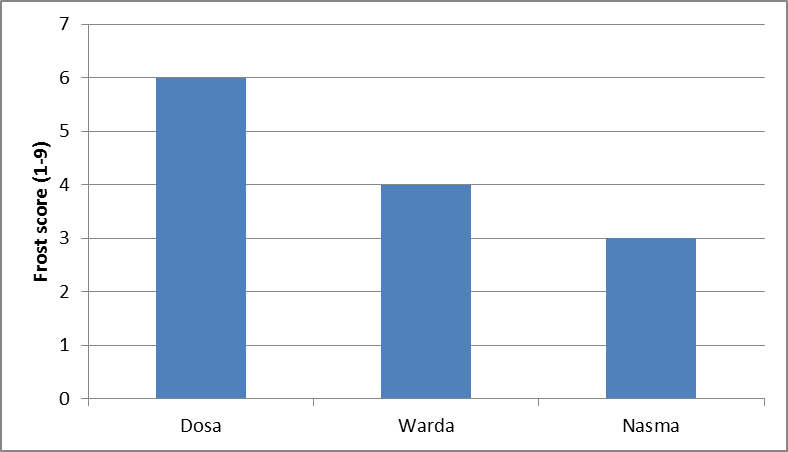Faba bean density experiments 2015 (Northern Winter Pulse Agronomy)
Faba bean density experiments 2015 (Northern Winter Pulse Agronomy)
Author: Andrew Verrell and Leigh Jenkins (NSW DPI) | Date: 23 Feb 2016
Take home message
- Sow faba beans at 20 plants/m2 in northern regions
- Sow faba beans at 30 plants/m2 in central regions
- Doza appears more prone to frost damage than either PBA Warda or PBA Nasma
Introduction
The 2015 season was characterised by severe frost events, episodic cold weather during flowering and terminal drought during grain fill. These seasonal conditions impacted heavily on crop performance, reducing the potential yield of faba beans across most areas of the northern NSW cropping zone.
The NPAI (Winter Pulse) project conducted a range of experiments covering a number of different agronomic themes in 2015. This paper reports on the outcomes of a series of faba bean variety x density experiments across northern NSW.
What did we do?
Faba bean 'variety x density' experiments were conducted at five locations across northern NSW in 2015. Three varieties were sown; Doza, PBA Warda and the new line PBA Nasma. Four target plant densities were examined; 10, 20, 30 and 40 plants/m2. All five trials were grown under dryland cropping conditions (i.e. not irrigated).
The three lines selected represent the two preferred commercial lines (Doza and PBA Warda) and the new large seeded line PBA Nasma. The difference in seed size for these commercial lines is shown in Figure 1 where PBA Nasma, on average, has seed that is 40% larger than Doza.
What did we find?
For grain yield, there were no significant interactions between variety and plant density; only main effects (see Table 1). PBA Warda and PBA Nasma out-yielded Doza at two of the five sites (Coonamble and Tamworth); while at Trangie, PBA Nasma out-yielded both Doza and PBA Warda (Table 1). Plant density showed significant responses at two sites; Cryon plateaued at 20 plants/m2, while at Trangie peak yield was obtained at 30 plants/m2 (Table 1). The remaining sites showed no yield response to plant density.
Frosts were prevalent across the northern region in 2015 and the Tamworth site suffered a number of severe frosts. From the 28th July to the 8th of August, 6 frosts were recorded ranging from -1.3 to -3.50C. This resulted in frost damage, causing elongating stems to develop a bent stick (hockey stick) appearance and blackening of leaf margins. Treatments were scored for frost damage on a 1-9 scale on the 7th August, with 1 representing no frost damage and 9 equal to plant death. Variety ratings are shown in Figure 2 with Doza significantly worse than both PBA Warda and PBA Nasma for symptoms of frost damage.

Figure 1. Average 100 seed weight (g) for selected faba bean varieties

Figure 2. Frost scores for faba bean varieties (1 = no symptoms, 9 = plant death)
Table 1. Grain yield (kg/ha) for the main effects of variety and plant density at five locations in 2015
|
Treatment |
Bullarah |
Coonamble |
Cryon |
Trangie |
Tamworth |
|
Variety |
Grain yield (kg/ha) |
||||
|
Doza |
1602a |
2900b |
1547a |
2036b |
2954b |
|
PBA Warda |
1687a |
3280a |
1700a |
2246b |
3296a |
|
PBA Nasma |
1685a |
3452a |
1686a |
2658a |
3359a |
|
Density |
Grain yield (kg/ha) |
||||
|
10 |
1498a |
3376a |
1373b |
1975c |
3177a |
|
20 |
1670a |
3411a |
1772a |
2275b |
3329a |
|
30 |
1768a |
3246a |
1673a |
2515a |
3210a |
|
40 |
1666a |
3270a |
1745a |
2489a |
3096a |
Values with the same letter are not significantly different.
Conclusion
Limited data from the first year of trial results in 2015 suggests that for northern and western sites 20 plants/m2 is a preferred target plant density, while in southern areas 30 plants/m2 is a better option to achieve optimum yield of faba beans grown under dryland cropping conditions.
Large seed does not necessarily confer higher yield; with PBA Nasma out yielding PBA Warda at only one location, Trangie.
Doza appears more prone to frost damage than either PBA Warda or PBA Nasma. Frost tolerance is a key attribute for the faba bean breeding program in northern NSW, with new releases (particularly PBA Nasma) targeted at having better tolerance than Doza.
Acknowledgements
The research undertaken as part of project DAN00171 is made possible by the significant contributions of growers through both trial cooperation and the support of the GRDC. The authors would like to thank them for their continued support. Thanks to Michael Nowland, Matt Grinter, Jayne Jenkins, Scott Richards and Gerard Lonegran (all NSW DPI) for their assistance in the trial program.
Contact details
Dr Andrew Verrell
NSW Department Primary Industries
Mb: 0429 422 150
Email: andrew.verrell@dpi.nsw.gov.au
Varieties displaying this symbol beside them are protected under the Plant Breeders Rights Act 1994.
GRDC Project Code: DAN00171,
